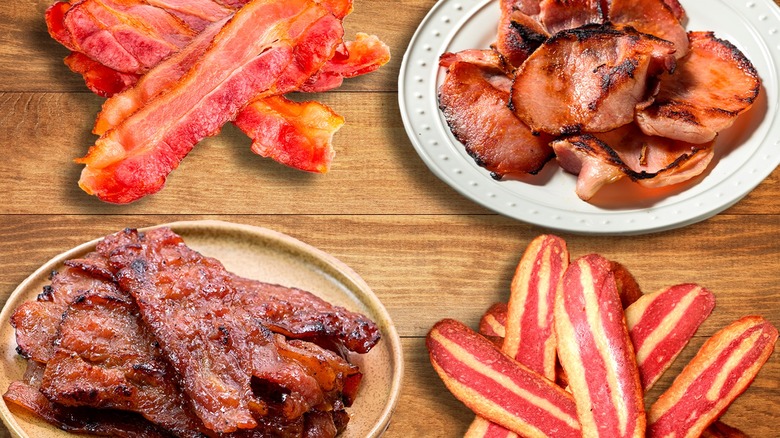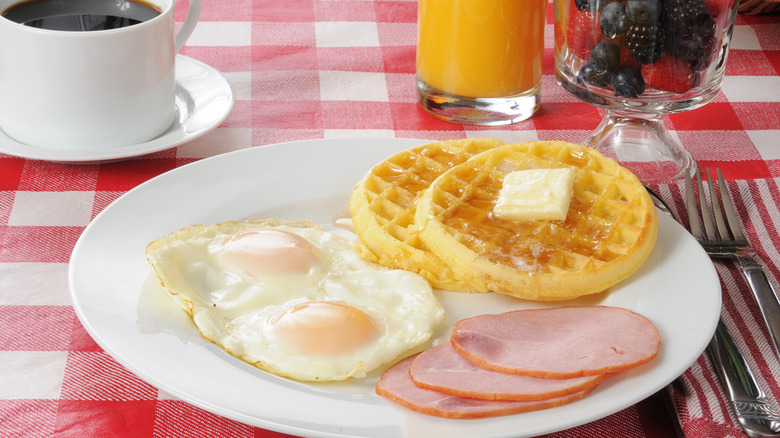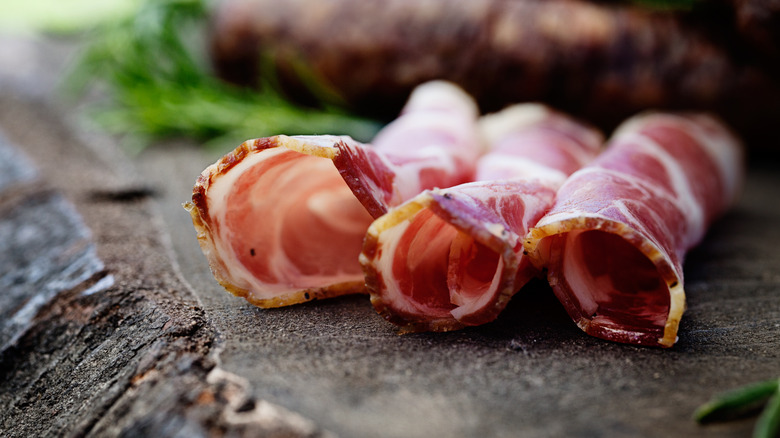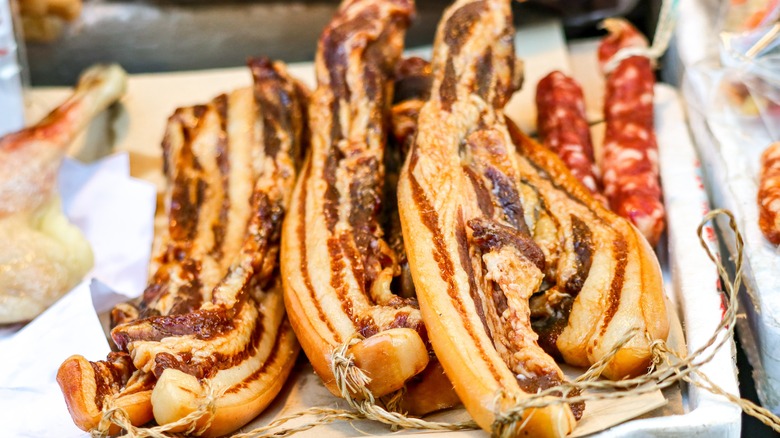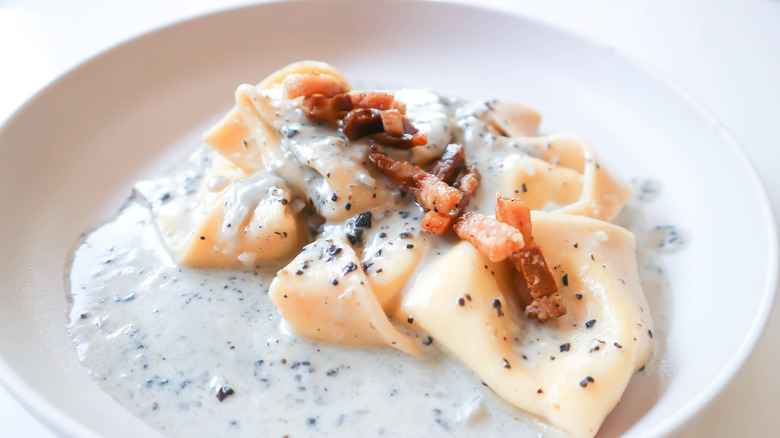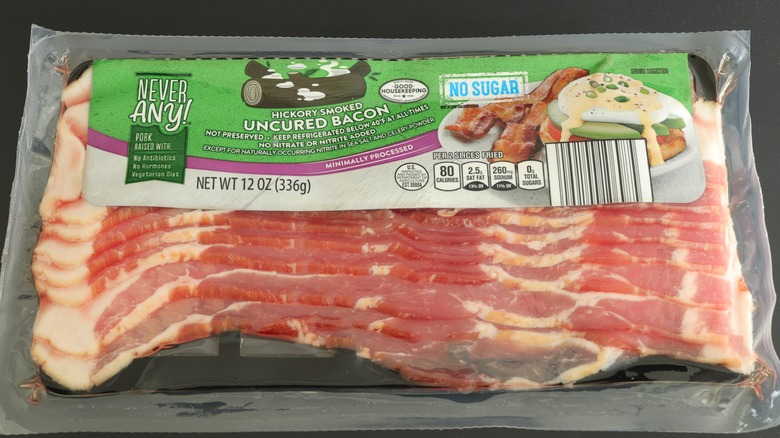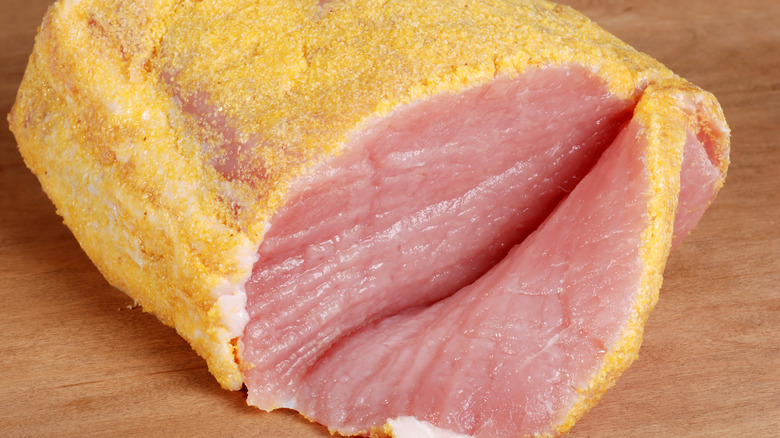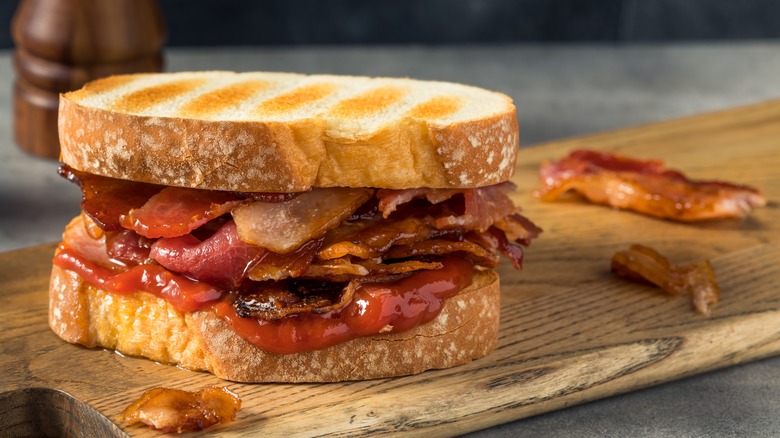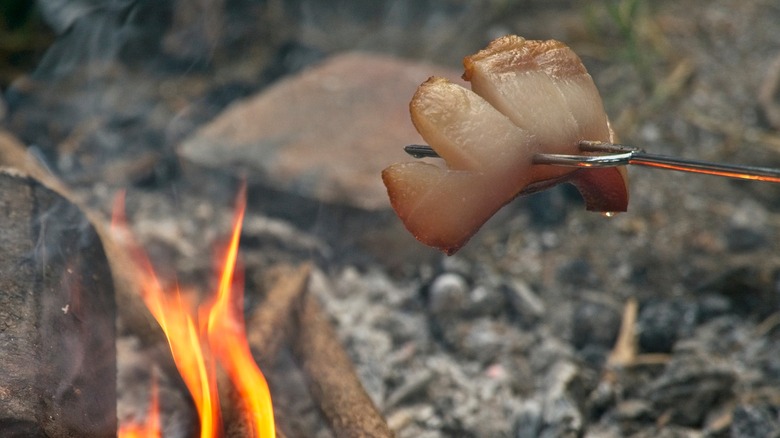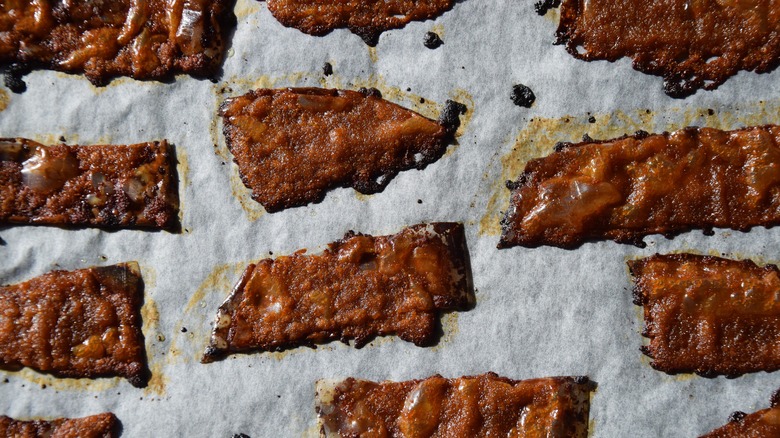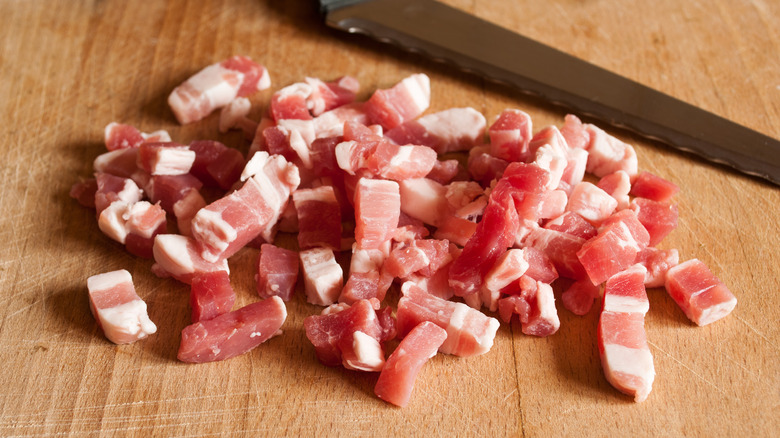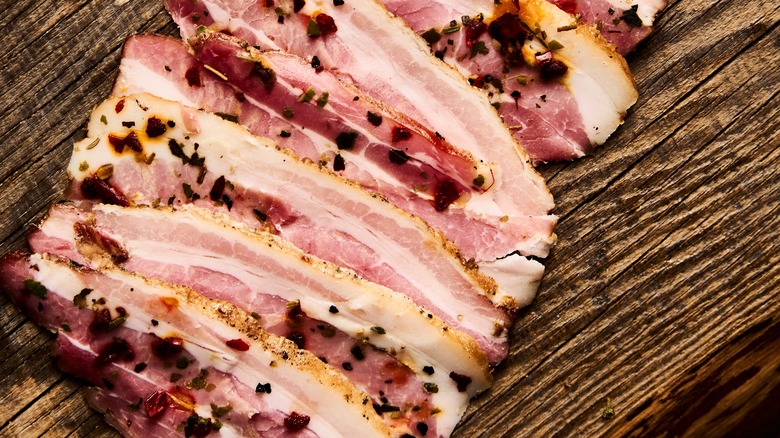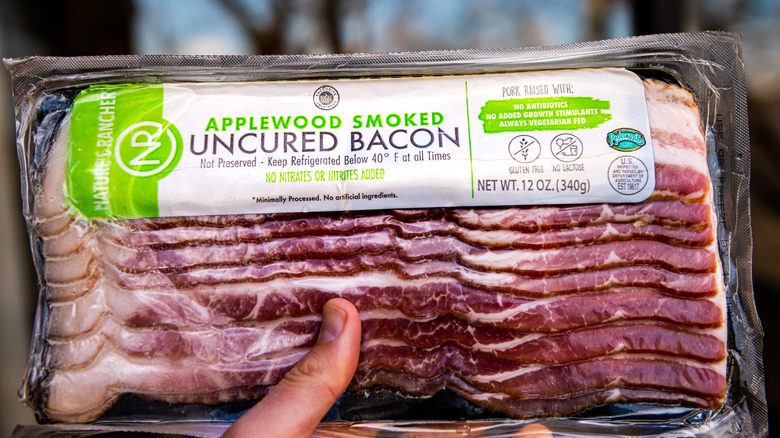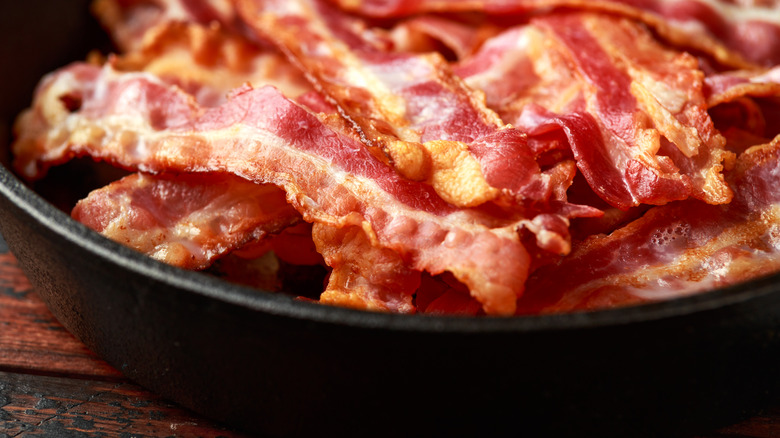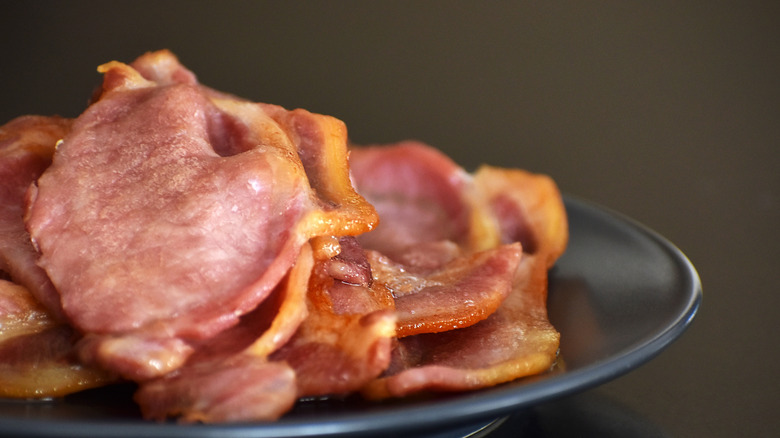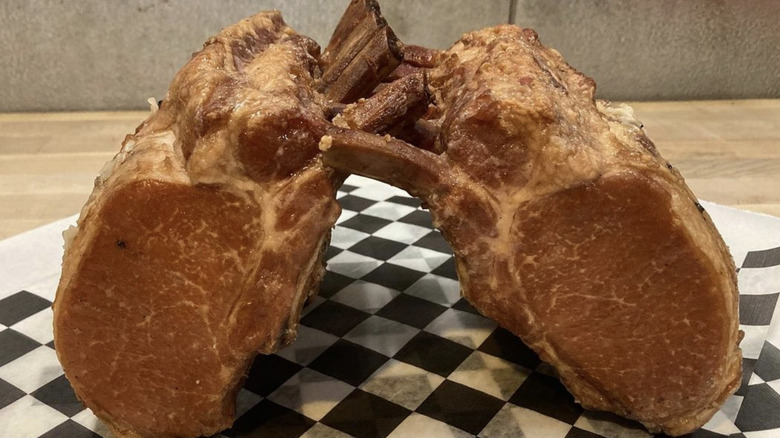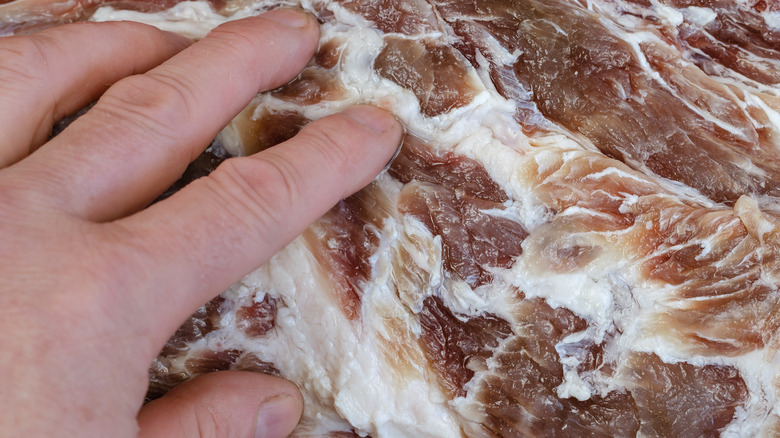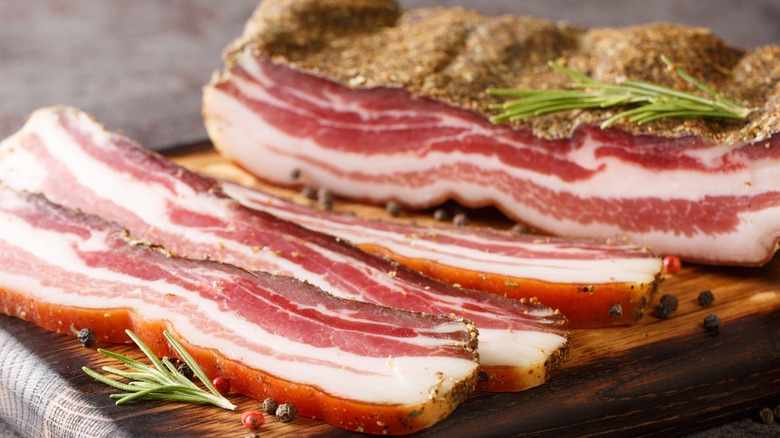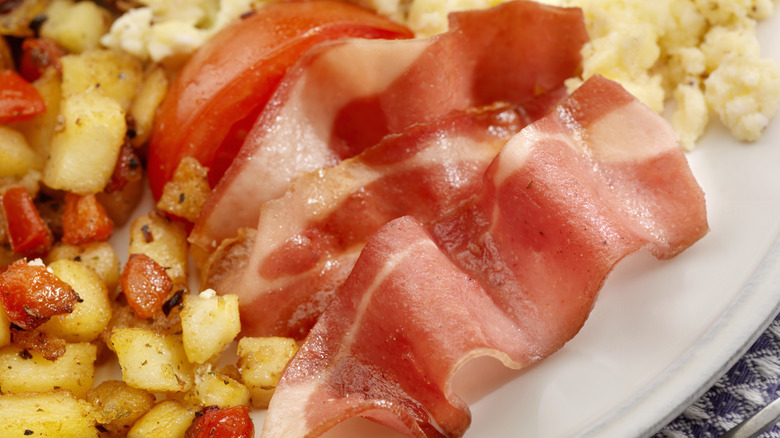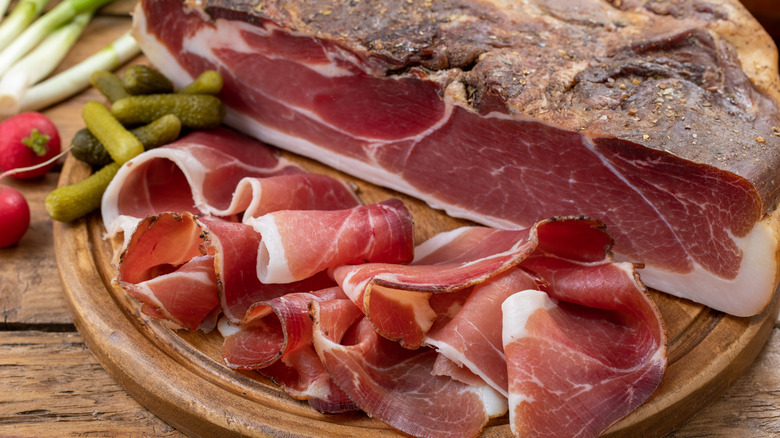21 Types Of Bacon You Should Know About
No breakfast meat carries quite the same affinity as bacon. Although Americans often love nothing more than a few slices served alongside their short stack of pancakes, integrated into their omelets, or even wrapped around foods that arguably didn't really need it in the first place, you can find many global iterations of bacon. Some utilize different cuts of the pig or are seasoned with regional ingredients, and all take this meaty staple to a new level.
We're here to highlight some of the most popular types of bacon, which you'll find not only in grocery stores but also in butcher shops around the world. The best part about the wide variety of bacon out there is that you may not have to travel halfway across the world to sample a particular cut; just ask your butcher for advice on which type to select, how to cook it, and how to best pair it with other ingredients.
Canadian bacon
Wait, Canadian bacon? Isn't that just ham? Believe it or not, Canadian bacon is actually bacon. The Canadians make this bacon from back cuts or pork loin, which resembles the British version of bacon. American bacon, also called streaky bacon, is sourced from the belly of the pig.
Another key difference that sets Canadian bacon apart from its American counterpart is that it is often sold fully cooked and ready to eat straight out of the package. Despite its ham-like consistency and color, Canadian bacon is a classic component of breakfast dishes like eggs Benedict, where the meat is topped with a poached egg and served under a generous blanket of hollandaise sauce.
Collar bacon
You can probably identify where exactly this cut is sourced based on its name alone. Unlike other types of bacon, collar bacon is derived from the shoulders of the animal. As a result, this meat is more consistently darkly colored with a fair amount of marbling, which concentrates the flavor. It's relatively difficult to find at a standard butcher shop, but you can always inquire about it.
One popular use for this cut is for an aptly named dish, collar of bacon, commonly enjoyed in Ireland. The collar is cooked with vegetables like cabbage or turnips, and served with potatoes. The collar of bacon can also be stuffed with aromatics like rosemary, and served with a buttery sauce made with the bacon stock.
Lap yuk (Chinese bacon)
Lap yuk is the Cantonese name for this sweet-salty bacon, but you may also hear it called là ròu. The key to making this type of bacon is the curing process, which is made with a mixture of popular Chinese ingredients like Shaoxing wine, soy sauce, star anise, cinnamon, and Sichuan peppercorns. The bacon strips sit in this mixture for several days before they are hung to dry outside in the elements.
Lap yuk is commonly made and eaten during the cooler months of the year, but modern technology and curing methods now allow the enjoyment of this meat year-round. Lap yuk can be used to season rice, or be integrated into a stir-fry.
Guanciale
This bacon variety takes us overseas to Italy, and like other classic Italian ingredients, guanciale doesn't skimp on the flavor. This cured meat is often referred to as pig jowl or pork cheek, and it's sourced from the animal's face.
Guanciale is one of the most versatile types of bacon. It can be used on charcuterie boards or as a bacon replacement on pizza. You'll also see it used in pasta dishes of Italy's central regions, especially in the red amatriciana sauce popular in Rome. The meat is used as a savory flavoring agent in these dishes; its high fat content and salty notes from the curing make it a unique addition to meals both in and outside of Italian cuisine.
Uncured bacon
If you take a walk through the grocery store aisle, you'll likely notice both cured and uncured bacon. The curing process typically involves the use of synthetic nitrites or nitrates to preserve the meat. Instead of being combined with these chemically produced additives, uncured bacon is cured with naturally derived nitrates. So, while uncured bacon is still cured (confusing, we know), it can have a saltier and more porky flavor than bacon treated with synthetic nitrites and nitrates.
Why is bacon cured in the first place? Beyond giving the bacon a pronounced color, the primary reason is that the additives make uncooked bacon stay preserved for longer — but let's be honest, how long does a package of bacon really last in anyone's house?
Peameal bacon
Canada has more to offer to the bacon world than just ham-like bacon patties. The country is also linked with peameal bacon, the Canadian breakfast food you should know. Like other types of bacon, this variety is sourced from the loin of the pig (like Canadian bacon) and wet-cured to infuse it with moisture. The main distinguishing factor of this type of bacon is that the fat is removed, and the entire piece was traditionally rolled in crushed yellow peas to give it a distinct coating. However, modern iterations of this meat are rolled with cornmeal instead.
While Canadian bacon is sold pre-cooked, peameal bacon must be griddled before it can be enjoyed. In Toronto, peameal bacon is a popular base for sandwiches, and these savory concoctions have even been named as one of the city's best specialties.
Slab bacon
Slab bacon is not a particular type of bacon, but rather the form that cured pork belly comes in before it's sliced into easily recognizable bacon strips that you can enjoy with a plate of eggs and toast. You can purchase slab bacon from the grocery store and cut it yourself to make lardons, or use it for certain dishes. Buying by the slab rather than in strips will allow you to add bacon to recipes that would cause strips to burn or cook too quickly. Instead, you'll get a gradual release of flavor — which is great for soups and slow-cooking recipes.
Another way to use slab bacon is to transform it into a condiment. Try whipping up an easy bacon jam recipe by cooking small pieces of slab bacon down with onions before adding in flavorings like brown sugar and vinegar.
Rashers (Irish bacon)
Irish bacon, aka rashers, is an important ingredient in the bacon butty sandwich. This is essentially a carnivore's dream — bacon is tucked between two pieces of bread and smothered in brown sauce or ketchup. However, the bacon used for this sandwich is different from American bacon.
Like the Canadian variety, Irish bacon is made with back bacon that has been sliced into rounds. Irish bacon tends to have a higher fat content than Canadian bacon. This adds extra moisture and flavor to the sandwich, and makes it the perfect cure for a particularly gnarly hangover. Besides a bacon butty, you'll also see rashers used for a full Irish breakfast, served with fried eggs, sausage, mushrooms, and tomatoes.
Szalonna (Hungarian bacon)
If you visit a Hungarian butcher, you're likely to find szalonna — or Hungarian bacon. There are many different varieties of this preserved cut of pork, and it isn't a surprise to see butcher stalls offering upwards of 20 different types. Szalonna is made with a very fatty cut of meat that has been salted or brined before it's smoked over hardwood to infuse it with more flavor.
A primary difference between different types of szalonna is the fat-to-meat ratio. However, you'll also see diversity in how Hungarian bacon is prepared. For example, sült császár szalonna is deep-fried and sold in large pieces, while paprikás Erdélyi szalonna is covered in sweet paprika to add extra flavor.
Hungarian bacon has several different uses. It's often used as a component of charcuterie platters, or it's served on a sandwich with veggies. It is also frequently cooked at szalonnasütés events, which are barbecue-style gatherings when everyone cooks szalonna pieces on skewers over an open fire.
Vegan bacon
We would be remiss if we omitted vegan bacon from this list. Carrot and coconut bacon are popular plant-based alternatives that are entirely meat-free. Instead, they're made by coating pieces of the produce in a smoky and savory marinade before they're cooked until crispy. You may also see some non-vegetable bacon alternatives, like rice paper — this can be used to make vegan bacon that's actually crispy, because the rice paper dries out in the oven.
You can also get a hefty dose of protein if you make your vegan bacon with tempeh or tofu. While these soy-based ingredients will never have the same texture as a fatty, meat-based bacon, it does still hit the spot.
Bacon lardons
Bacon lardons are a great way to build flavor in dishes. These cubed or matchstick-cut small pieces of slab bacon are made with uncured pork fat or salt-cured pork. Once the lardons are sliced into the desired shape, they can be sautéed with vegetables and aromatics to add texture and fat. Lardons are a great addition to soups that can use a salty, savory undertone.
Lardons are typically sliced into ¼ inch pieces, and they contain a solid ratio of bacon to fat. You can purchase pre-cut lardons from the butcher counter at the store, but sometimes you may have to carefully slice the slab yourself. This will allow you to cut the bacon into any size you need, which is especially important considering how much lardons can shrink as they cook.
Cottage bacon (buckboard)
Cottage bacon is much meatier than conventional pork bacon because it's made with the shoulder of the pig rather than the belly. It's typically made with pork cuts that you can find at the butcher, including Boston butt, pork butt, or picnic shoulder. Since some of these cuts can be bone-in, it may take some finesse to prevent ripping the meat apart. After the cottage bacon is cured and smoked to infuse it with flavor, it can be sliced into thin pieces that resemble the size and shape of classic bacon.
One of the benefits of making buckboard bacon is that it's significantly cheaper than buying packaged bacon strips from the store, since whole shoulder cuts are usually less expensive per pound. You can also customize the flavor of your meat by using a special cure or swapping out the wood you smoke it with.
Pancetta
If you're wondering what makes pancetta and bacon different, you're not the only one. After all, it's not uncommon to see recipes that note that one can be substituted for the other.
Pancetta is an unsmoked form of bacon found in an array of Italian dishes. Similar to standard bacon, pancetta is derived from pork bellies. Like other types of uncured bacon, pancetta is technically "cured" with flavorful ingredients like black pepper, cinnamon, nutmeg, and cloves. After the cure is applied, the pancetta is rested for between eight and 15 days to be fully infused with flavor.
If you ate pancetta and bacon side-by-side, you would notice that pancetta doesn't have the classic, smoky bacon flavor. However, it has the porky quality typical of uncured bacon. So, you'll want to use pancetta for applications where you need a softer, gentler bite — like in carbonara, or as a deli meat for sandwiches.
Applewood-smoked bacon
When perusing your supermarket's meat section, you're likely to see applewood-smoked bacon. The "applewood" component of the name just refers to the type of wood used to smoke the bacon. This wood has a soft and slightly sweet flavor to it that carries over into the meat.
Beyond preservation, the primary purpose of smoking meats is to infuse them with flavor. The smoking process dries out the meat to protect it from microbial growth during storage, while the slow infusion of smoke imparts flavor to the bacon. Applewood might be one of the more common firewood varieties for smoking bacon, but you may also find hickory-smoked bacon in the store.
Streaky bacon (American bacon)
If you order a side of bacon with your breakfast in America, it will likely come with streaky bacon. This bacon is sourced from the belly of the pig rather than the loin. The belly area has more fat interspersed through it, which causes its namesake streaks. It also tends to be shaped into actual strips, rather than the rounds you'd see with Canadian or back bacon.
Streaky bacon can be used for a variety of purposes, but it's truly best when cooked in a pan and served as a side dish to a meal. Since the strips are so thin, they are more difficult to chop up and use in recipes than thicker cuts, like slab bacon or lardons.
Back bacon
As you'd expect, back bacon is sourced from the back of the pig. This cut of meat is significantly more lean than bacon sourced from the belly, so it doesn't offer the same indulgent flavor.
Rashers are a type of back bacon, but some nuances make it complex to explain what sets them apart. Rashers are commonly sourced from the very center of the loin, whereas back bacon encompasses any meat sourced from this area of the pig. Back bacon has a wide diversity of cuts that will influence its texture and flavor, whether you cut it from near the shoulder or closer to the rear of the animal.
Bacon chops
You may have eaten a pork chop at least once in your life, but what about a bacon chop? Bacon chops, aka bacon steaks, are sliced comparatively thicker than bacon strips. Each bacon steak is sliced about ½ inch thick after it's been cured. The steaks are sourced from the loin of the pig.
Think of bacon chops as a much more delicious way to eat bacon. Since bacon is arguably the best part of a fried breakfast, it makes sense that you would want to have more of it on your plate. Bacon chops are also great when prepared with a flavorful glaze and either grilled or baked for a hearty weekend meal.
Wet-cured bacon
Wet curing is a specific process used to infuse flavor into ham. A wet cure is exactly what its name implies: The meat is suspended in a liquid brine infused with an array of aromatics and seasonings. On many occasions, a wet cure will use the same flavorings as a dry version.
There are numerous benefits to opting for a wet cure. The first is that the seasonings can more easily penetrate into the meat, and this technique also speeds up the curing process significantly. But since the solution is diluted in the brine, the flavor of wet-cured bacon isn't as potent as a dry-cured version. And because wet curing often involves injecting the meat with the brine, you can also expect that wet-cured bacon will have a moister consistency.
You can treat wet- and dry-cured bacon similarly — for the most part. But it's important to remember that wet-cured bacon will shrink dramatically when it's cooked, because the brine will evaporate when exposed to heat.
Dry-cured bacon
Dry curing is another way to infuse flavor into the meat while helping preserve it. The process starts by rubbing a large cut of bacon in an array of spices, herbs, sugar, and, most importantly, salt. The salt will help pull moisture out of the bacon via osmosis. As a result, dry-cured bacon tends to have a more prominent flavor since there is less water in the meat after the cure is complete. Once the meat is cured, it is rinsed and air-dried to form a coating on its surface, called a pellicle.
The amount of time needed for the cure depends on the seasoning, cut, and thickness. But, if you're dry-curing bacon at home, you can expect to wait for up to a week before you can take it to the smoker.
Turkey bacon
Turkey bacon has long been touted as a healthy alternative to pork bacon. Not only does it contain fewer calories and fat, but it's also relatively easy to whip up as a companion to your breakfast. Unlike pork bacon, which can be clearly sourced to particular cuts of the pig, turkey bacon is an amalgamation of finely chopped poultry pressed into strips. Sometimes producers utilize streaks of white and dark meats to further resemble classic bacon strips. It's also often mixed with preservatives that help give turkey bacon a pink hue and a pork-like texture.
Because of the processing required for this meat, it's best to purchase one of the store-bought turkey bacon brands rather than attempting to make your own version at home. Once you have a pack of turkey bacon, you can pop it in a skillet, bake it in the oven, or even cook it in your microwave.
Speck
There are some important differences between bacon and speck. Regionally speaking, speck is often associated with Italy's South Tyrol province, but some German pork products also bear the title of speck. The Italian version is made with the leg of the pig and seasoned with a specific mixture of juniper and bay leaves. After it's properly seasoned, the speck is smoked and cured, a process that allows speck to be consumed directly from the package. The flavor can be described as bolder than prosciutto and somewhat similar to pancetta.
Speck can be used for more than being served on a charcuterie board — it can also be caramelized or grilled to concentrate its meaty, complex flavor. One popular use for speck is as a stuffing for the Italian bread dumplings called canederli.
